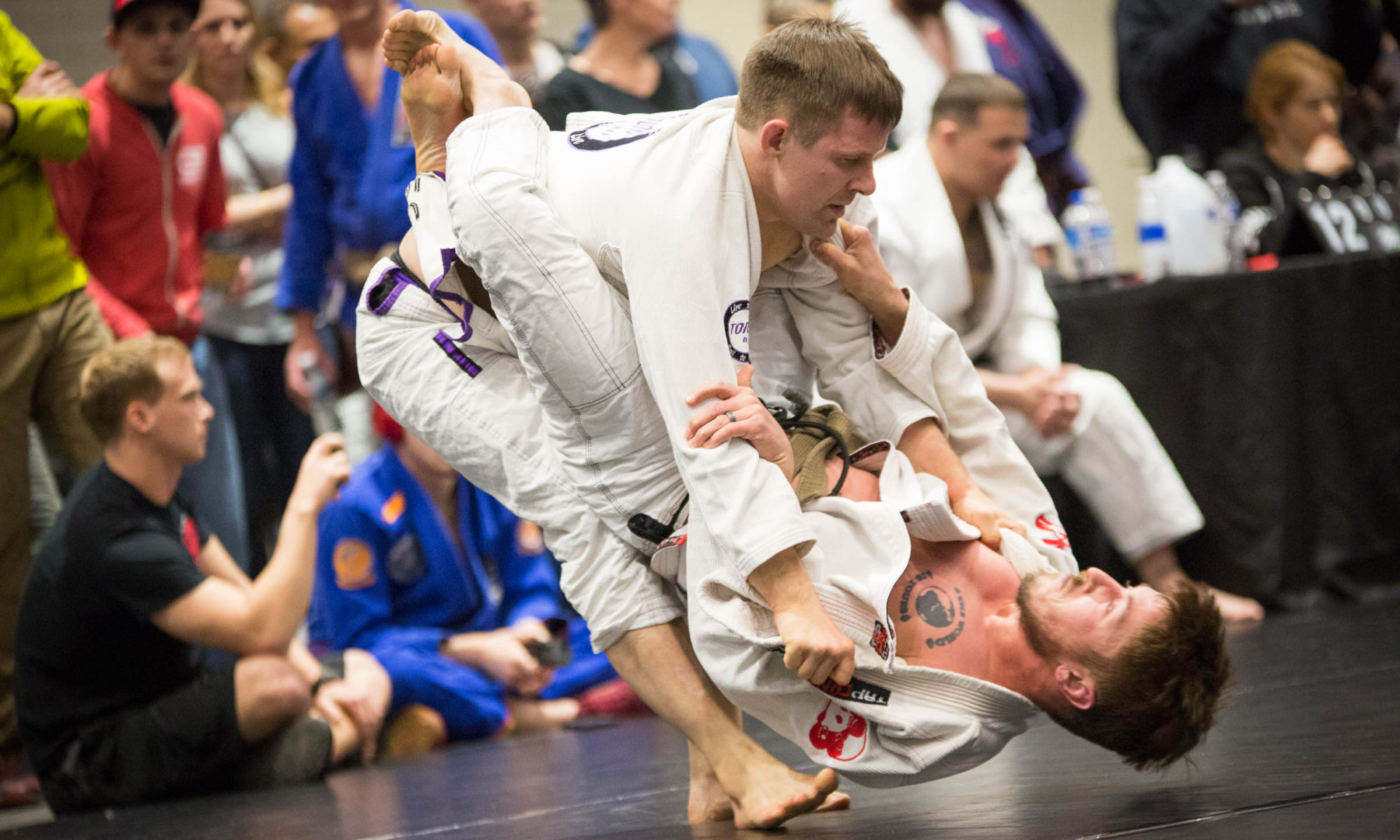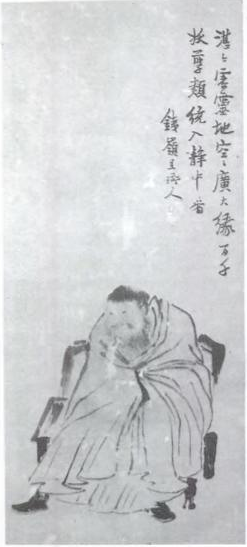Great breakdown on a drill used by former guest Chris Clodfelter of Eight Points Muay Thai on attacking with knees and entering into the clinch!
Posted by Dirty White Belt Radio on Friday, September 30, 2016
Video: Your Job As a Blue Belt
This Sunday's guest, Royce Gracie black belt Jake Whitfield, talks about what blue belts should be doing in training. Sunday at 10 a.m., Jake reveals who his toughest MMA opponent was, what the hardest day of training in the barn looked like, what a judo pin has to do with stabbing someone in the neck, and what the most common training mistakes are. He also calls at least one of his students a sissy. Tune in to find out which one.
Posted by Dirty White Belt Radio on Friday, May 6, 2016
Visualize It, Don’t Criticize It
This morning at 6 a.m. jiu-jitsu class, I talked about iterated algorithms. Let me apologize here to all of the students that I hit with that number before daybreak or coffee, and thank the one person who nodded vigorously when I asked “does anyone know what an iterated algorithm is?” (An algorithm that’s been iterated. Duh).
I’ll get back to math-nerdiness in a moment, but let’s start with peer-reviewed study nerdiness. Why should you keep reading? Because this post is about a very simple way that you can improve competition performance — with minimal effort and no risk of injury. You can even do it if your time at jiu-jitsu class is limited. That simple method is visualization.
When I say visualization, here is what I mean: you use your mind to visualize the way you want your match to go. When I’m preparing for competitions, I do this a lot during my off-the-mat time. In fact, I’ll be doing visualization constantly all the way up to my time in the bullpen preparing for tournament matches. I’ll visualize myself doing all the techniques that I’d do if the match goes exactly the way I want it to: single leg takedown, knee cut pass, knee drive to mount, mounted collar choke. In my mind’s eye, I guide myself through all of these steps.
To name one benefit, it helps me be calm and focus in that nerve-wracking time before I step on the mat. But there are more benefits, and study after scientific study has shown that using visualization techniques has myriad benefits, including improving sport-specific skills, improving strength and coordination. Bluntly, visualizing a guard pass will help you pass the guard more effectively.
Skeptical? A host of studies bear this out, on topics as widely varied as strength training, golf, judo and other skills-based competitive activities. While I’m hardly an expert on this research, I’ve read more than a few studies on the topic. There is a broad general agreement on the fact that visualization has benefits, although the theories about why these benefits exist vary. But you don’t care overmuch about the why, do you? You want to pass the guard better. You want better results.
So let’s get you there. First, I’m going to review some of the visualization studies I’ve read. That’ll hopefully convince you that this is a thing you should be doing, because this is rigorous, peer-reviewed research. Second, I’m going to tell you my method of visualization, which hasn’t been tested by anybody, but seems to work for me. Then we’ll get back to iterated algorithms. How can you not stay to the end after that teaser?
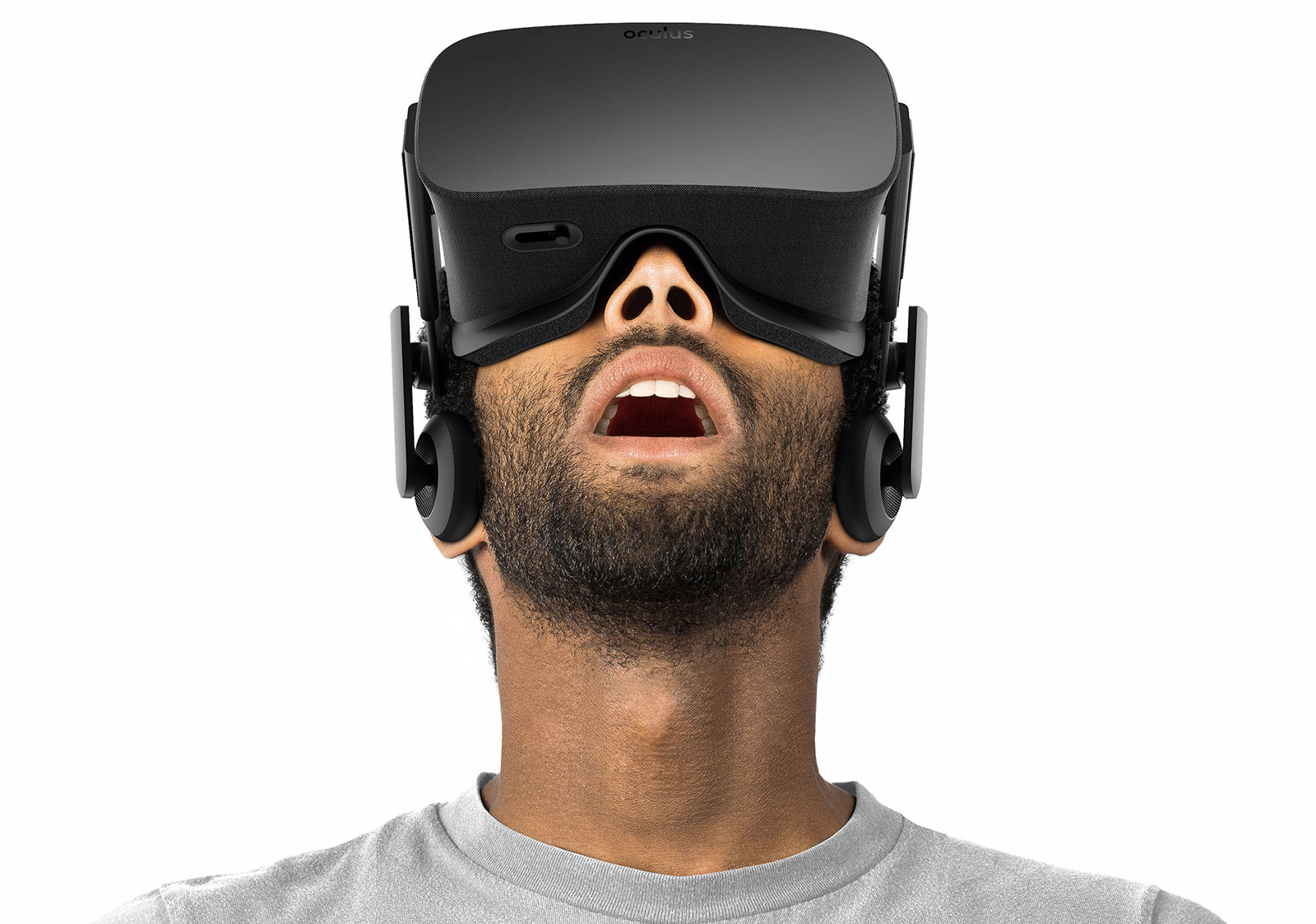
Here’s the big picture: many, many different studies have been done on this, trying to establish whether we can prove that visualization effects are real. I’ll get into the specific studies in a second, but sometimes the most convincing evidence is a review that takes into account a bunch of research. Let’s say, for example, someone did a meta-study that examined more than 20 research projects into visualization’s effects. If they found a general trend toward major benefits, that would tell us something, no? Check this out:
Empirical research suggests that mental practice may enhance the performance of motor skills. Many variables have been shown to mediate the size and direction of the mental practice effects. The purpose of the present study is to provide an overview of research examining the role played by these variables in mediating the effectiveness of mental practice. In order to integrate the findings in the literature and to further analyze the relative contributions of each of these variables, a meta-analysis was performed according to the procedure outlined by Smith, Glass, and Miller. Twenty-one studies that met the criteria of having both an adequate control and a mental practice alone group were included in the meta-analysis. The forty-four separate effect sizes resulted in an overall average effect size of .68, (SD = .11) indicating that there is a significant benefit to performance of using mental practice over no practice. (emphasis added)
In summary, scientists picked 21 of the best studies they could find, and those studies had to have a way of determining whether mental practice alone could be shown to have a benefit. In those studies, there were 44 “effects” shown from visualization. And while these effect sizes varied, they were found to show clear and significant benefits to performance across the board.
Whenever I read a single study, my inner skeptic tells me to be cautious of the conclusions. You can find one study that says virtually anything you want it to. When it’s a couple of dozen well-designed studies across decades, you get on much more solid ground.
If groups of studies are more convincing, specific studies are more fascinating and evocative. Just check out the narrative from this guy’s thesis, describing a couple of important research projects and their conclusions.
In addition, Eddy & Mellalieu (2003) elaborated that the use of imagery techniques to imagine performing a specific sports skill has been shown to improve the physical performance of that. Using the mind, an athlete can register positive images over and over, enhancing the skill through repetition or rehearsal, similar to physical practice. Therefore, with mental rehearsal, minds and bodies become trained to actually perform the skill imagined. Imagery and visualization is the development of creating a mental image or goal of what he/she wants to happen or feel. Research by Newmark (2012) supports visualization was first applied to sports performance after the 1984 Olympics, when Russian researchers studying Olympic athletes found that Olympians who had employed visualization techniques experienced a positive impact on their biological outcomes and performance. (emphasis added)
To a certain extent, this is intuitive. Our brains run on electrical impulses, and using our brains to visualize, say, a sweep, seems like it should get the right patterns set in our brains. Besides, most of us spend an all-too-brief time actually on the mats during the week. The knowledge that thinking about the motion of shrimping while you’re sitting at your desk might improve your jiu-jitsu is powerful. While there’s certainly no substitute for hard physical training, it’s helpful to know that mental training — which you can do anywhere — can afford additional benefits.

When I say “benefits,” I’m talking sport-specific benefits. Take golf, for example. Two different studies tracked golfers on their putting accuracy: one found “significant performance improvements” in putting from visualization, and the other found that “using positive imagery” (i.e., imagining a successful putt instead of a missed putt) had a “significant main effect on performance improvement.” We’re talking a very specific motor-skills task here, folks: visualizing yourself striking a putt and having that putt go in makes your putting more likely to be accurate.
It’s not just golf, of course. Martial artists will be thrilled (and hopefully unsurprised) to learn that visualization while training judo not only helps you learn judo techniques, it also helps your “imaging” knowledge, your ability to successfully visualize. Like any task, the more you do it, the better you get at it, and the more you think about it, the better you get at thinking about it. When you put it that way, it seems like common sense, right?
Finally, one study that really blew my mind — and, to some researchers, hints at the mechanism by which visualization works. It’s one thing to talk about visualization improving your body’s coordination. But research shows that it increases your actual muscle strength as well. Read that again. Visualizing muscle movement actually increases your muscle strength. You remember in the Matrix, how Keanu Reeves had never used his muscles before, but he still could, y’know, move? Turns out that’s not so unrealistic.
Researchers asked 30 young, healthy volunteers to participate in the study. Eight of them were trained to perform “mental contractions” of their little finger muscles, without actually moving the muscles. Eight other people did the same mental task, but with elbow movements. Six other volunteers actually did the finger muscle movements instead of thinking about them. Then the remaining eight weren’t trained at all, physically or mentally, and served as a control group.
After the 12 week study concluded, they found this:
At the end of training, we found that the [mental-only finger movement] group had increased their finger abduction strength by 35% (P < 0.005) and the [mental-only elbow flexion] group augmented their elbow flexion strength by 13.5% (P < 0.001). The physical training group increased the finger abduction strength by 53% (P < 0.01). The control group showed no significant changes in strength for either finger abduction or elbow flexion tasks. The improvement in muscle strength for trained groups was accompanied by significant increases in electroencephalogram-derived cortical potential, a measure previously shown to be directly related to control of voluntary muscle contractions. We conclude that the mental training employed by this study enhances the cortical output signal, which drives the muscles to a higher activation level and increases strength. (emphasis added)
This tells us that yes, physical exercise is best for building muscle — but mental training can build strength, too. The mind is powerful.
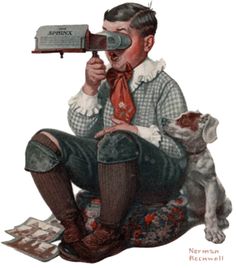
One caveat: the practice of visualization in these studies isn’t standardized, so there’s some variability in how people use terms like “visualizing” and “imaging.” This doesn’t mean you shouldn’t do it: in fact, if that judo study is to be believed, the more you do it, the more efficient you’ll be (just like jiujitsu itself).
Rather than take you through all the methods used in these studies, I’m going to tell you how I do it, why I do it that way, and what that has to do with an iterated algorithm. I haven’t been the subject of any research studies since I was a kid, so I can’t prove what I do works, but it makes me feel more prepared, and that’s valuable in and of itself.
Given that the research shows that positive imagine has a greater impact — and that Marcelo Garcia says “I don’t worry about what the other guy’s going to do” — I start out by visualizing my ideal match, where everything goes right. I see myself doing the techniques that I’d choose to do if everything works perfectly. For me, those techniques are:
Single leg takedown > Knee cut guard pass > Knee drive pass to mount > Mounted collar choke
What can I say? I’m a simple man who likes choking with his hands. This plan, given the techniques I know and do, is my optimal world. Obviously, you can change it up and insert your ideal match techniques as well. I run through these techniques in my mind over and over before my match.
As we all know, no plan survives engagement with the enemy. Often, people are pesky, and they don’t let you just dominate them from stem to stern. Plus, sometimes I just choose to pull guard. And finally, it’s boring to imagine the same match in the same order over and over.
An iterated algorithm is a concept from math. You start with a number (or point), then process it somehow to obtain a new number or point. When you integrate that new number/point into the process, you create a “feedback mechanism” — and after a while a pattern emerges.
You can think of how I do visualization as several iterations, or, if you prefer, a Choose Your Own Adventure book. I start from the ideal match (Single leg takedown > Knee cut guard pass > Knee drive pass to mount > Mounted collar choke). Then, I insert some changes into the system. What if I get taken down? Maybe it’s:
Get double legged > Recover guard > Tripod sweep > Knee cut guard pass > Knee drive pass to mount > Mounted collar choke
Or what if the process is disrupted in the middle? Maybe he recovers guard, and I have to pass again:
Single leg takedown > Knee cut guard pass > He recovers guard > Torreando pass > Back Take > Bow & Arrow Choke
You can see that the possibilities are infinite. But two commonalities remain: first, I always visualize finding a way to win the match; and second, I keep the visualizations to my A-game techniques, the most likely tactics that I’ll have to use. This keeps all my best options in the top of my mind. It also gives me something to do in the bullpen, which is nice.
In most competitive pursuits, the person who is able to impose their game on the other party wins. This is why drilling and rolling are both important: getting to your happy place quickly and efficiently is critical.
If you want both your mind and your body to get to that happy place more often, try visualization. No iterated algorithms required.
How A Critic Is Different From a Hater
In that moment, I was as mad as I can remember being.
I was at a major tournament with a bunch of people from my school. One of my good friends and teammates was about to compete (I won’t say names, so as to obscure the details, since the principle isn’t about this specific incident). He was competing against a highly-regarded competitor from a major competition school. The two competitors were ready to step on the mat, and I was preparing to coach and yell support.
What I wasn’t prepared for: a large upper belt from the other guy’s school starting to talk loudly about … well, let me just quote:
“Our guy is going to crush this guy,” he said. “I mean, LOOK at him.” He continued from there. It got progressively more disrespectful, and although this guy out-ranked me and out-weighed me by a fluffy 100 pounds, it started to feel like he was the Chester half of Chester and Spike. He went on about how our guy looked compared to his guy. Eventually, I asked my roommate to stand between me and this guy so I wouldn’t say or do anything stupid.
The match started, and the fluffy brown belt kept talking — until it became apparent that this would be a tough match after all. At about two minutes in, he stopped talking altogether. The match was neck and neck the whole way. My teammate wound up losing, but it was a terrific performance, and I was proud, and the portly gentleman was both much relieved and much quieter. He exhaled, did a small celebration, but there was none of the mess-talking that had been so present before.
Then came the moment that solidified in my mind that I would one day tell this story. One of Fluffy Brown’s teammates asked about when they’d see him compete.
“Oh, I’m basically a hobbyist,” he said. “I train twice a week, and I don’t compete any more.”
After I heard that, I had to take a walk.
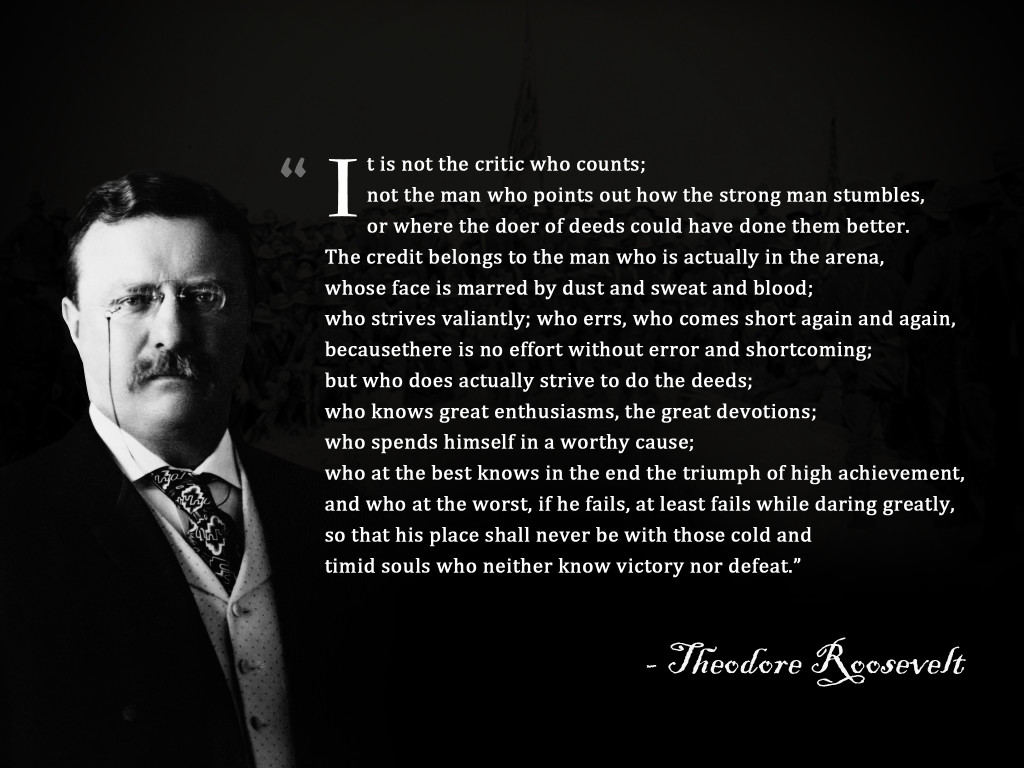
You’ve no doubt seen this quotation from President Theodore Roosevelt before. That’s because it’s classic, and it expresses numerous important ideas. Foremost among them is that it’s better to come up short again and again that to simply point out “where the doer of deeds could have done them better.” If we want to build great things, we have to try, and we usually have to fail at first. As the playwright Samuel Beckett put it: “Ever tried. Ever failed. No matter. Try again. Fail again. Fail better.”
I want to make a clear distinction here. Though Roosevelt uses the word “critic” here, I don’t think the guy I’m describing counts as a critic. I would use a different word, a word that is thrown around a lot, and is often overused and misapplied. That word is hater.
Critics, in fact, are valuable. No one is above criticism. In fact, we should welcome good-faith criticism. It’s how we learn and grow.
When your instructor tells you to stop taking top position against new people, that’s not hate: that’s identifying the next step in your evolution. When a visiting black belt takes the time to explain why you’re not finishing from the back, it can feel like a scolding, but it isn’t. It’s a learning opportunity. It’s criticism, not hating. A good critic is invaluable, because a critic identifies flaws in your approach — and flaws can be fixed.
A critic has the doer of deeds’ best interests at heart. A good critic tells you where you’re making mistakes in open guard positions so you can fix those mistakes. A hater doesn’t deal in good faith: they point out the weaknesses in your open guard (or career, or life) so they can feel better about their own.
A critic advances us towards becoming our best self. A hater tries to tear us down to their level. Your coach is a critic. Your supportive teammates are critics. The guy who makes fun of you for trying is a hater.
It’s important not to confuse the two. A good high-profile example of confusing the two came recently when Rener Gracie penned a note entitled “to the loyal haters.”
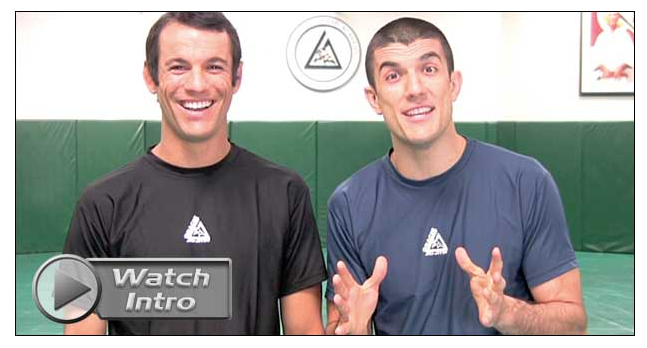
Gracie University has come under a good deal of scrutiny over the past few years, first for online belt promotions. More recently, it’s been because of the rapid proliferation of schools with lower-belt instructors.
In Rener’s note, he refers to the folks scrutinizing the way Gracie University has developed as “haters.” That’s not accurate, in my view. Of course, there are some people on the Internet that will take any opportunity to take pot shots at anyone. Many of the people who were concerned about the online belt system, though, were respected black belts. And even people who think a Certified Training Center run by a blue belt might be a good solution for a rural area with no legitimate training for 100 miles — I count myself among these — think it’s a terrible idea to drop a blue belt who has studied mostly online right next to a school run by Gracie Jiu-Jitsu black belts and pretend like there’s nothing wrong.
Notice what these have in common: each has a solution. People have legitimate concerns about online belts? You can modify or end that program. People think that a mostly-online blue belt shouldn’t be represented as equivalent to a 10-year black belt? There are structures that can be put in place to guard against that.
None of this is possible, though, without being open to critics — not haters, but critics.
Sometimes, folks like to think they have haters. If you’re being singled out for criticism, you’re special. You’re different. You’re important. And if you are these things, then any critique of your work is simply hating.
There are two problems with this. First, it doesn’t necessarily reflect humility. We all can make mistakes, and few of us are so important that people are going to sit around thinking of meritless criticisms.
And I think most people do operate in good faith. I think more people want to help you than want to hurt you. I think you’re not much different than anybody else, trying to get better at something you like doing, and the people criticizing you aren’t hating so much as trying to demonstrate they have something to offer. I think Morrissey was wrong.
What, then, is hating? Hating is when you’re not critiquing in good faith. It’s when you’re criticizing Rener Gracie just because of who he is, rather than the way he’s going about his project. It’s when someone tries something new and, instead of honestly interrogating the project to see if it’s worthwhile, you treat the project like Rick James treated Eddie Murphy’s couch.
If you’ve noticed, there’s a fine line to walk here. I don’t think that only people who compete have a right to criticize others (although if you don’t compete at all, you might shy away from criticizing other people’s teammates in front of them during a tournament); instead, I think that criticism should come from a constructive place. On the other side of things, I think people who create things need to be open to critical thoughts from observers.
Here’s the most important thing. If you take only one thing away from this post, I would have you remember this:
It’s easier to destroy than it is to create; tearing things down is also quicker than building them.
If we want to have good things in the jiu-jitsu community, we have to not be quick to tear down the people who try to build them. If we want to have great things in the jiu-jitsu community, the people who build things have to be open to hearing what might make their efforts better.
Making the Mind Empty in the Surf
Surfing and martial arts share much. Top-level practitioners, for one thing: a healthy percentage of the Brazilian black belts I met grew up surfing, and professional surfers like Joel Tudor have taken up the gi with great enthusiasm and success.
You can see why, since both arts require adaptability and grace in the face of powerful opposing forces. The ocean’s tougher than all of us.
Another point of commonality: the experience that surfers (and psychologists) call “flow,” that optimal experience of life. Jiu-jitsu people use the term “flow” sometimes, too, but it’s more typical in the circles I run in to hear it called “mushin,” a Japanese word that roughly means “empty mind.”
There’s really no experience like it. I got it when I was doing competitive debate during high school and college, and haven’t had it since — until jiujitsu.
Putting this type of experience into words is a weighty task. I won’t make too strenuous an attempt, because it seems contrary to the very notion of an empty, flexible mind. I’m merely going to describe how it seems to me during a perfect sparring or competition experience.
They come for you and grab you, hard. You off-balance them and then you’re on top and they don’t know what happened. Things are slow, slower than life ever is. They try to grip you again, and you watch their hand come open as it reaches for you. It could take what seems like a second or what seems like a year, and you know where on your body it will land precisely.
But you’re not there any more. The hand’s efforts are useless. Then you let them grip you, just to show them they shouldn’t grab you there, and suddenly they’re tapping.
I don’t use the word sublime a lot, but not much else qualifies. The world is gone. Life is right here.
***
We often talk about martial arts as a practice, and other disciplines from sporting to religious to philosophical use that same terminology. The end results you’re aiming for with these disciplines differ widely. It’s the practice that brings focus, clarity, and the ability to experience what we call flow. It took me years to get there in both debate and jiu-jitsu, and I’m certainly not there every session. But, as with yoga or music or whatever your art of choice is, it’s the practice that matters.
Buddhism talks about emptying the mind in the context of meditation. This is a painting by the Chinese artist Gao Qipei:
You’ll notice that a poem is inscribed at the top of the painting (about which there’s another fascinating story, involving Bertolt Brecht, but that’s for another time).
The poem is about using a quiet mind to tell the difference between good men and evil ones. Here’s a rough translation:
“The deep clarity of the empty mind
corresponds to the vast emptiness of the sky.
All these malicious and evil men
can be seen in the stillness of contemplation.”
There is a difference between using mental clarity in evaluating someone’s personal ethics and in knowing intimately whether the kimura is available, but how you get there is the same: slow progress over time, culminating in the acuity to know instinctively what to do when the time is right.
Besides, every discipline has different aims, some of which exist beyond good and evil. To paraphrase Ash from the Evil Dead films: “Good, bad. I’m the guy with the heel hooks.”
The idea of mushin is divergent from daily life experience for most of us. We work day jobs that require constant attention. Whether you’re sitting in an office or waiting tables, your mind is active and thinking about minute details. If the world slows down in these spots, it’s not because of the flow, it’s because the quotidian is making you watch the clock.
What does this all mean? It means that the New Year is almost here, and with it, I’m thinking my annual thoughts about what to improve during the next trip around the sun.
I always play the Lawrence Arms song “100 Resolutions” at this time of the year, because the chorus is something to aspire to. You can see why it’d make me think of mushin:
This year I’ll try not to think too much.
This year I’ll try to stand up for myself.
This year I’ll live like I’ve never lived before.
This is my year, for sure.
https://www.youtube.com/watch?v=pBQc4fwj33c
This year I’ll practice more. Not just jiu-jitsu, but all the things that get me away from clock-watching and toward quiet. This year I’ll flow more and force things less, and I’m not talking about while rolling. The world will always make waves in my life, but I will learn to surf them better.
These are all things I wish for you, too. Happy New Year, everyone.
Why BJJ Lineage Matters
Without a fighter from Japan and a few Brazilian pioneers, I wouldn’t be writing this blog. Without a black belt from Vermont, I wouldn’t be competing at high-level tournaments. Without a select handful of dedicated people, I would be a completely different person than I am — a less happy, less tough person leading a less fulfilled life.
That last paragraph is about my lineage in jiujitsu, the teachers that have trained me. We think about that a fair bit in the martial arts.
Interestingly, a new guest article on JiuJitsu Times purports to not see why lineage matters. While I see where the author is coming from — yes, in a fight or a tournament match, no one cares who your instructor is — the piece wildly misanalyzes what lineage is and why it’s important. Continue reading “Why BJJ Lineage Matters”
There is no such thing as spider guard
“A writer who is afraid to overreach himself is as useless as a general who is afraid to be wrong.” –Raymond Chandler
A new guard comes out every week. It’s remarkable how, after billions of years of evolution and thousands of years of human grappling, completely unforeseen positions somehow crop up every time there are DVDs to be sold.
It’s also interesting how, when a new guard is “created,” we’re treated to marketing efforts that inform us how innovative it is, how cutting edge, how devastatingly effective.
Hyperbole has its value, of course, as the Raymond Chandler quotation from above emphasizes. You’ve got to believe in what you do, and you have to market your instructional. Also, believe you me, I’m going to engage in a little hyperbole, right now.
Here it is: There is no such thing as spider guard.
Or worm guard. Or koala guard, or God help me mantis guard. There is no such thing as any of these.

There is only the guard. And the guard has principles. Every good and useful position within guard adheres to these principles.
Many times, fancy terminology for allegedly innovative positions disguises the fact that these “new” guards have been played for years — or worse, it distracts us from one fundamental concept of good guard play.
Now, obviously I don’t mean “the positions typically described as spider guard positions do not exist.” That’s where my own hyperbole comes in. I want you to consider the idea “there is no such thing as [insert name of guard position]” in terms of a thought experiment.
The positions exist. But when discussing the guard with new students, it’s more helpful to explain to them the concepts of what a good guard means rather than tell them “go straight to this specific guard position that you must use.” When we describe these positions, we should see this terminology as helpful visual shorthand and nothing more.
First, I’ll talk about why the last paragraph I wrote is true. Next, I’ll focus on why understanding the fundamental principles of guard is important. And finally, I’ll talk about what this idea means for those of us who train.
Why Is There No Such Thing As Spider Guard?
When we use the guard, whether in a sport environment or a self-defense situation, there are certain things we must do. Primarily, we must control distance.
If we don’t control distance, we aren’t safe, and if we aren’t safe, nothing else matters. There are a variety of ways we can do this, both in closed guard and open guard. But all of them require us to understand this: we are building structures. Our structures could be a solid closed guard. They could be feet on the hips in proper position. Could be a leg lasso, or any number of things.
The particular structure is less important than the idea that guard is a process of creating our own powerful structures while preventing our opponent’s structures from developing.
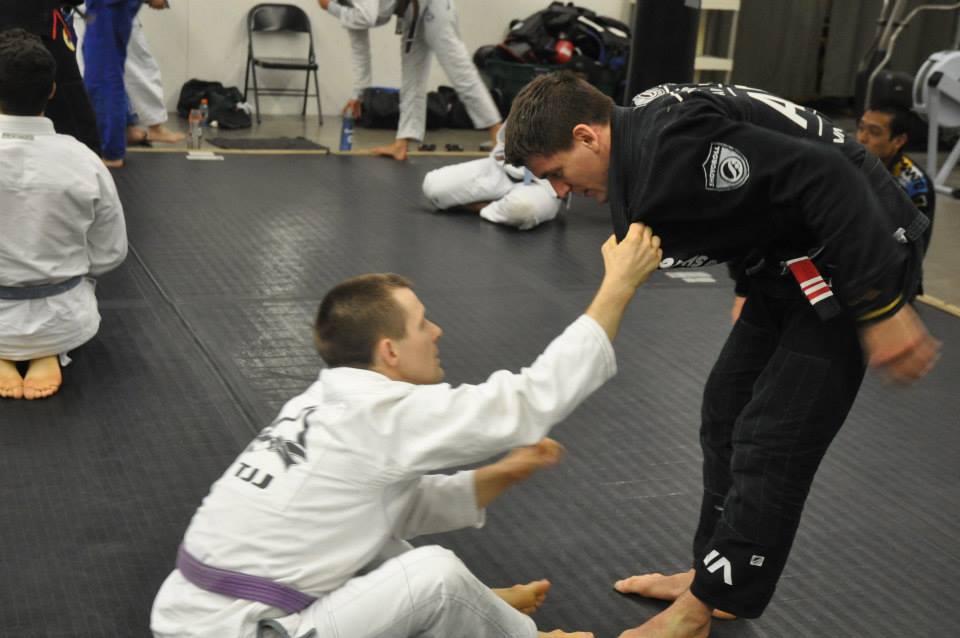
In order to build good structures, I have to control the inside space. If I grab my opponent’s arms on the outside of his triceps, he is in a more powerful spot than I am — not to mention that he can punch me. But if I use my hands to make hooks on the inside of his biceps, or if I grab his sleeves and step on his biceps, passing and punching becomes nigh impossible until he breaks my structures down.
“Wait!” You might be saying. “You just said ‘step on the biceps!’ You just said spider guard doesn’t exist, but you’re describing spider guard!”
This is exactly the point I’m trying to make. To achieve the goals of guard, I need to build structures. In order to do this, I need to step on targets. The most powerful targets are typically hips, biceps and shoulders. Why are these most powerful? Because they control the inside space.
Try passing a guard or punching someone without clearing their hands, feet or knees off your biceps. As long as you hit and maintain those targets, your structures are working. You can call that “spider guard,” for sure. But it’s more important, especially early on, to understand why the position we call spider guard works. And that there are other positions in the guard universe that serve the same function.
As Royce Gracie black belt Roy Marsh put it in a conversation with me, “guard is just structures that allow movement which can then build better or new structures.” This is a really important insight — that structures allow movement —for the next section.
Why Is Realizing “There Is No Such Thing As Spider Guard” Important?
Early on in my training, the De La Riva guard made sense to me. It just felt natural. I think certain positions like this pop up for all of us: there’s just this one thing that you gravitate to as a thing you understand and enjoy.
The biggest mistake I made in my early blue belt years: when I got in trouble, I held onto that De La Riva guard like a sinking ship. That changed when I took a private with Vicente Junior, an amazing black belt directly under Ricardo de la Riva.
He gave me an insight that is also reflected in the Roy Marsh dictum above: the guard is about movement and transition. When someone clears your De La Riva hook, you can fight like hell to get it back —or you can transition and step on a hip. When someone stuffs your foot between their legs, you can exhaust yourself trying to get whatever guard you want back — or you can move to Reverse De La Riva.
Jiu-jitsu is about efficiency, and fighting like crazy for specific positions isn’t efficient. If I’ve built a good structure, that structure will allow me to move.
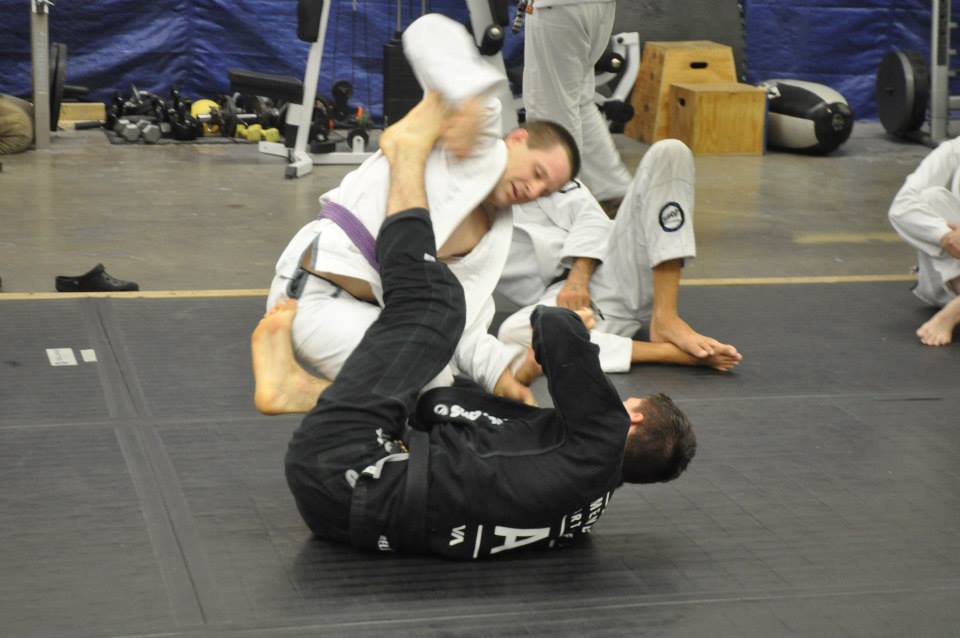
For me, realizing that I wasn’t a De La Riva Guard Player was a key insight. My DLR hook could become a hook elsewhere (inside the lead leg) or hit a target (a hip, a bicep). That way, I control distance. I maintain control of the inside space. I play guard, not “De La Riva guard” or “spider guard.”
I think if we teach new students these core principles as we teach them particular positions, it will be better for their long-term growth. Don’t just “play spider guard,” understand why spider guard works — and what stops it from working. That way if they clear your foot from a target, you aren’t exhausting yourself trying to do exactly that one thing — or worse, totally lost.
What Does All This Mean?
I want to say one other thing about fundamental principles, and then I’ll give the three things I hope you’ll take away from this post. All of these ideas apply to passing the guard too. It’s a game of structures, or building them and breaking them down.
If we have good fundamentals, we can prevent a lot of problem situations. Often, adhering to these core concepts can defeat the so-called “modern” open guard before they get started. One of the things Ze Grapplez did very well in our match this year, and a key reason he won, was that he prevented me from even getting my open guard going.
He did this with sound pressure passing that stopped me from — stop me if you’ve heard this — controlling distance and dominating the inside space. Once he achieved that, I was playing catch-up and I never caught up. If your opponent stops your offense before it gets started, it’s hard to win.
So, to sum up:
1. Fundamental principles are important, and by and large they don’t change: think of targets and hooks and structures, not ultra-specific positions.
2. Thinking of yourself as a Spider Guard Player or a De La Riva Guard Player or whatever it is can blind you to one of the most critical aspects of guard — the ability to move and transition.
3. Don’t always believe the hype about the hot new guard. Close your guard. If it opens, control distance, dominate the inside position, build good structures and keep yourself able to move. Whether you call that open guard, panda guard or Double Secret Probation guard doesn’t matter.
Actually, just call it Dirty White Belt guard. I could use the clicks. Happy training!
